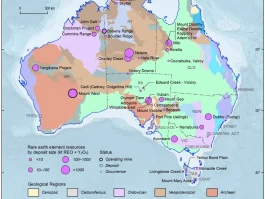When the news broke that China was tightening its grip on rare-earth metal exports, I saw the headlines flash across my screen, each one more alarmist than the last. "China tightens export controls on rare-earth metals: Why this matters." "Trade War Escalates." "US Tech in Jeopardy." "Defense Industry Under Threat." And I can just imagine the scene: in boardrooms from Silicon Valley to the Pentagon, you could probably hear a pin drop, the silence punctuated only by the low hum of servers processing the grim implications.
But when this news hit my inbox, my first thought wasn't fear—it was a jolt of pure, unadulterated opportunity. This isn't a crisis. This is a starting pistol. This is the "Sputnik moment" for 21st-century materials science, the kind of shock to the system that doesn't just nudge innovation forward, but launches it into an entirely new orbit. We’ve been hitting the snooze button on supply chain independence for decades, and Beijing just smashed the alarm clock.
The World's Most Important Choke Point
Let's get on the same page about what we’re talking about here. "Rare-earth metals" is a bit of a misnomer. They aren't particularly rare in the ground, but they are incredibly difficult to mine and process cleanly. Think of them as the essential vitamins for our technology—you only need a tiny amount, but without them, absolutely nothing works. The vibrant reds in your LED TV, the powerful magnets in an F-35 fighter jet or a Tesla’s electric motor, the polished lenses in your smartphone camera—all of them owe their existence to these 17 obscure elements on the periodic table.
Now, imagine one company controlled 90% of the world’s yeast. You can have all the flour and water you want, but if you want your bread to rise, you have to go to them. You have to play by their rules. You have to hope they’re in a good mood. That’s precisely the situation we’ve allowed to develop. China doesn't just mine over 60% of these metals; it processes a staggering 90% of them. They’ve built an almost complete monopoly over the one ingredient that makes modern technology possible.
So when Beijing announced it was adding five more metals—holmium, erbium, thulium, and the rest—to its restricted export list, bringing the total to twelve, it wasn't just a bureaucratic filing. It was a calculated move in a high-stakes geopolitical chess match, played just weeks before a critical meeting between the US and Chinese presidents. They laid their kingmaker piece on the board and dared the world to make its next move. The message was clear: our technology, our defense, our green energy transition—it all runs through them.
But here’s the question nobody in those panicked boardrooms seems to be asking: What if being held hostage is the best thing that could have happened to us?

The Unintended Gift of Scarcity
History is filled with moments like this. The oil shocks of the 1970s felt like an economic apocalypse at the time, but they gave birth to a revolution in fuel efficiency and sparked the first serious investments in solar and wind power. That pressure, that sudden, terrifying scarcity, forced a generation to think differently. It forced us to innovate. This is the same principle, just with different elements on the periodic table.
This move by China is a declaration that the age of easy, outsourced, and dangerously centralized supply chains is over—and I say good riddance. It’s the catalyst we desperately needed to finally get serious about building a resilient, independent, and, dare I say, more imaginative technological future. The speed at which this forces us to adapt is just staggering—it means the gap between today’s problem and tomorrow’s solution is closing faster than we can even comprehend, and that’s where the real magic happens.
For years, brilliant minds in labs at MIT and across the country have been working on the theoretical edges of this problem. How do we create powerful magnets without neodymium or dysprosium? How can we design new semiconductor materials that sidestep the need for gallium? How can we perfect "urban mining"—the science of efficiently reclaiming these precious metals from the mountains of e-waste we create every year? These weren't front-page projects because the cheap, easy stuff was always just a shipping container away.
Not anymore.
This is the kind of breakthrough that reminds me why I got into this field in the first place. This pressure creates diamonds. It will unlock funding, cut through red tape, and unite researchers, entrepreneurs, and national labs around a single, galvanizing mission. It’s a challenge that reframes the entire paradigm. The goal is no longer just to find a new place to dig, but to invent our way out of digging altogether. Can you imagine a world where the most advanced components in our lives are built from abundant, recycled, and ethically sourced materials by design? That’s the future this "crisis" makes possible.
Of course, this comes with a profound responsibility. We can't just replicate the old model of extraction and environmental shortcuts in new locations. The real victory isn't just about shifting our dependence from one nation to another; it's about transcending that dependence entirely through superior science.
The Spark We Didn't Know We Needed
Let them play their game of geopolitical chess. Let them squeeze the supply of holmium and terbium. It feels like a threat, but what they’ve actually given us is a gift. They’ve given us clarity. They’ve given us a mission. They have inadvertently kickstarted the next great materials science revolution. This isn’t the end of our technological leadership; it’s the beginning of its most creative and resilient chapter yet. We were getting comfortable. Now, we have to get brilliant. And I, for one, can't wait to see what we build next.

